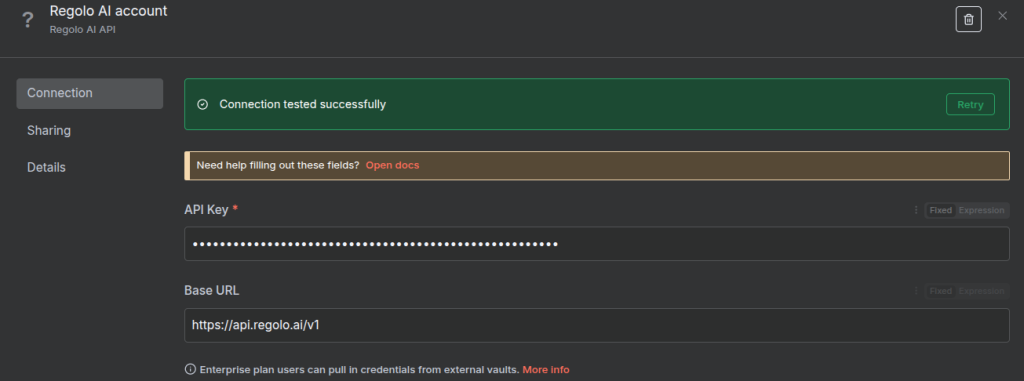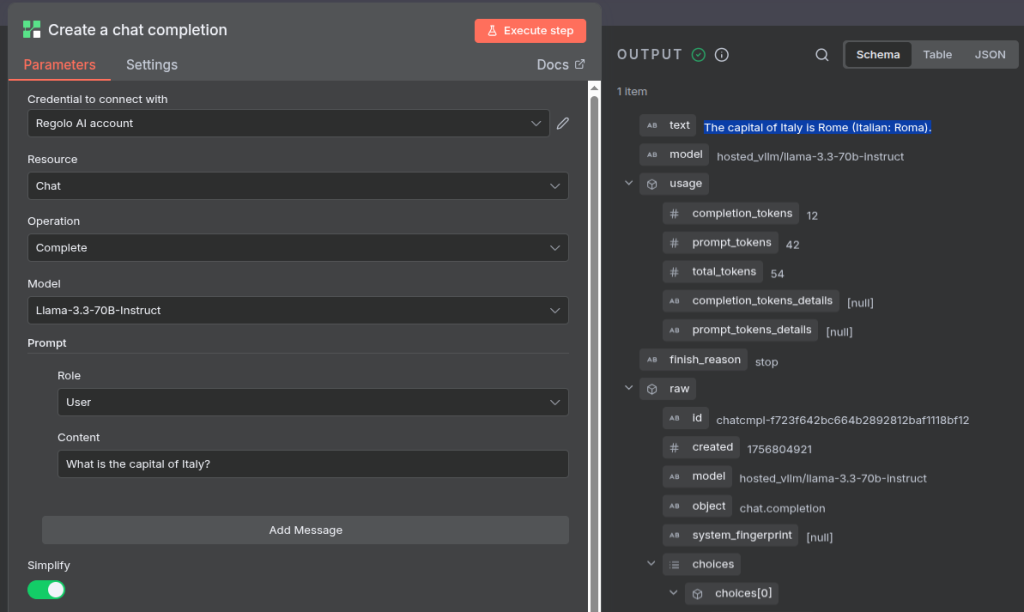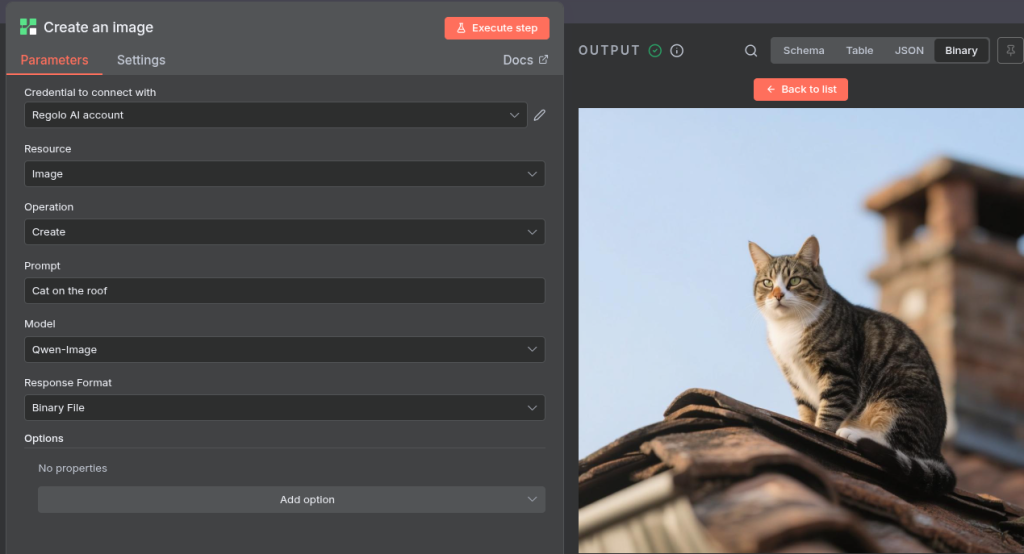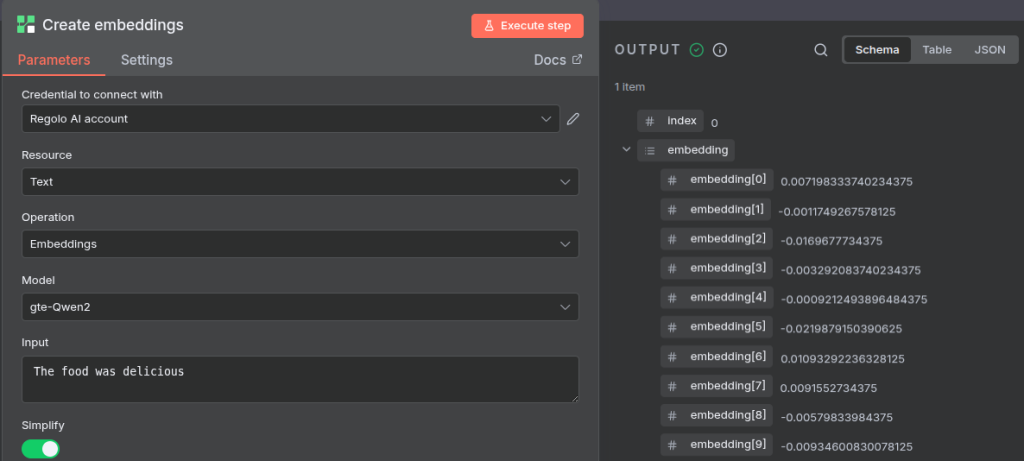We’re thrilled to announce that Regolo.ai is now integrated with n8n!
From today, you can seamlessly connect the advanced capabilities of Regolo.ai directly into your automated workflows, alongside the dozens of services and tools you already use with n8n.
This means that conversational reasoning, embeddings, and image creation are now just a node away. No need to set up manual API calls or deal with complex integrations, simply drag, drop, and let n8n + Regolo.ai do the work.
What is n8n?
It’s a platform that lets you build automated workflows, integrating AI into a wide range of contexts.
Why this integration is a big deal
Until now, connecting external AI providers often meant juggling credentials, writing custom API calls, or dealing with compatibility issues. With this native integration, Regolo.ai becomes a first-class citizen inside n8n, bringing you:
- Frictionless automation → AI becomes part of your workflow like any other service. No custom code required.
- Flexible models → Leverage Regolo.ai’s Large Language Models directly as nodes inside n8n. Perfect for reasoning, conversation handling, and structured outputs.
- Embeddings & image creation → Go beyond chat: build semantic search pipelines with embeddings or generate stunning images for your creative workflows.
- Familiar setup → If you’ve already used OpenAI or Anthropic nodes in n8n, you’ll feel instantly comfortable. Regolo.ai is fully aligned with that experience, but with its own unique strengths.
How it works 🔧
Inside n8n, search for Regolo.ai in the action menu.
This node is connected directly to Regolo.ai’s API using your credentials.
Use this node for text completions, embeddings or image creation.
The setup takes just a few seconds: drag the node, drop it into your workflow, configure your key, and you’re ready to go.


Available actions include:
- Chat Completions – generate or continue conversations with an AI model (select the one you prefer). Regolo.ai offers many new AI models, such as: deepseek-r1-70b, gpt-oss-120b, qwen3-coder-30b…
- Image Generation – create images from natural language prompts. Try now Qwen-Image!
- Embeddings – transform text into numerical vectors for similarity search, clustering, or semantic tasks.
Prerequisites
You’ll need Docker installed on your machine. Please refer to the official Docker documentation for installation:
Installing n8n on your machine
We’ll install n8n using Docker. Start by creating a volume for persistent data and then run the container with the following commands:
docker volume create n8n_data
docker run -it --rm --name n8n -p 5678:5678 \
-v n8n_data:/home/node/.n8n docker.n8n.io/n8nio/n8nCode language: JavaScript (javascript)First login
With your n8n Docker container running, open http://localhost:5678 in your browser to access the application.
On your first visit, you’ll be prompted to fill out a form to create the owner account, which will allow you to manage your workflows.
After completing the account setup, you’ll be asked a few questions about how you plan to use n8n. Finally, you’ll have the option to request a free Community Edition license key, just enter your email address, and the key will be sent to you.
After logging in, you need to install the Regolo.ai integration package to enable all functionalities. Simply run the following command in your ROOT directory:
npm install n8n-nodes-regoloaiThis will add the Regolo.ai nodes to your n8n instance, making them available for use in your workflows.
Setting Up Regolo.ai Credentials
Before using Regolo.ai in your workflows, you need to configure your API credentials inside n8n.
- Go to Credentials in the n8n menu.
- Search for “Regolo.ai Account” or “Regolo.ai API”.
- Enter your API Key provided by Regolo.ai and the base URL: https://api.regolo.ai/v1
- Save the credentials and test the connection to ensure everything works.
Once saved, you can reuse the same credential in all Regolo.ai nodes (chat, image, embeddings) without entering the API key again. This makes setup quick, secure, and consistent across workflows.

Creating a Chat Completion
In the Chat Completion node, you can configure:
- Model: Select from available models (e.g.,
Llama-3.3-70B-Instruct). - Prompt: Provide user input or dynamic values from your workflow.
For example, asking “What is the capital of Italy?” returns the response:
The capital of Italy is Rome
The output includes both the text answer and metadata such as token usage, model name, and response ID.

Generating Images with AI
Regolo.ai also supports image generation.
In the Create Image node, you can set:
- Prompt: Describe the image you want (e.g., “Cat on the roof”).
- Model: Choose an image model such as
Qwen-Image. - Response Format: Define whether the output should be a binary file or a URL.
In the example, the model generates a realistic image of a cat sitting on a rooftop.

Creating Embeddings
Embeddings are useful when you need to compare, classify, or search text.
In the Create Embeddings node, you can specify:
- Model: e.g.,
gte-Qwen2. - Input: Any text you want to encode (e.g., “The food was delicious”).
The output is a vector of floating-point numbers, which can be stored or processed in later steps of your workflow.

📚 Useful resources
Final thoughts
With Regolo.ai on n8n, you’re not just automating tasks you’re making your workflows smarter.
From chatbots to advanced reasoning, from semantic search to image creation, the possibilities are endless.
Whether you’re streamlining customer support, building creative tools, or enhancing internal processes, Regolo.ai is now right where you need it: inside your n8n workflows.
